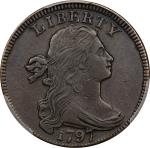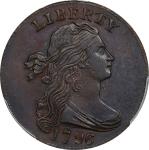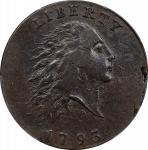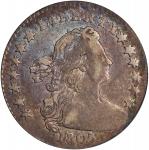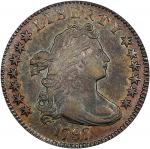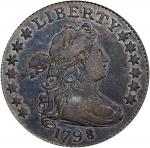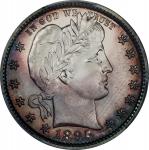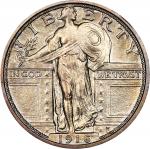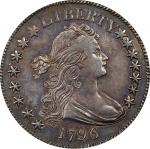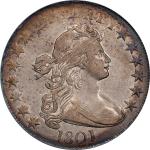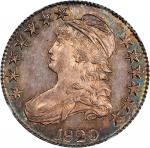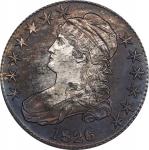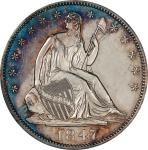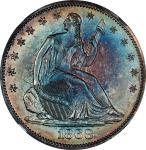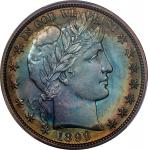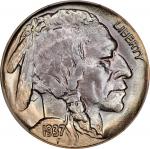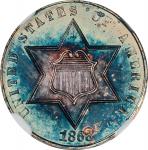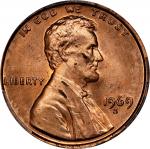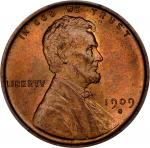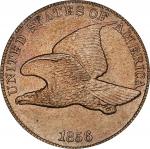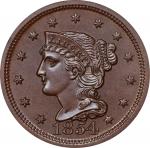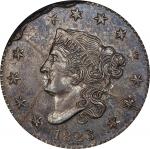1792 Half Disme. LM-1, Judd-7, Pollock-7, the only known dies. Rarity-4. MS-64 (PCGS). Smith-Orosz-Augsburger Coin 64-1. <strong>Obv:</strong> A bust of Liberty with short, curly hair faces left, the date 1792 in small digits immediately below the curved truncation of the bust. The legend LIB. PAR. OF SCIENCE & INDUSTRY is around the border, an abbreviation of "Liberty, parent of science and industry." <strong>Rev:</strong> A small eagle with spread wings faces to the left with the denomination HALF DISME and a single star below. The legend UNI. STATES OF AMERICA encircles most of the reverse periphery. All 1792 half dimes except for the unique copper impression (Judd-8) are struck in silver with a diagonally reeded edge, and a single set of dies was used to complete the entire mintage of approximately 1,500 pieces. The coins were struck with medallic alignment.<p>This is a truly memorable example of the scarce and historically significant 1792 half disme. The strike is uncommonly well executed for a type that often displays blunt central definition and/or incomplete denticulation around the borders. On this coin, all focal design elements are sharp except for a few of the highest curls of Libertys hair and isolated high points of the eagles breast, wings and left leg. The denticulation is absent along the right obverse and lower reverse borders due to less than perfect centering - characteristic of this die state (see below), and hardly detracting to the coins appearance. The impressive features of this coin are fully appreciable given the outstanding level of preservation at the desirable Choice Mint State PCGS grade. Free of wear, the surfaces retain full frosty to modestly semi-prooflike luster that is most intense in direct lighting. The entire coin is draped in rich blue-gray patina that attests to the coins originality.<p>Following passage of the Mint Act of April 2, 1792, the Treasury Department made arrangements to set up a mint. Although there had been private mints in America dating back to the days of the Massachusetts Bay Colony, this was to be the first federal institution. Dr. David Rittenhouse, an eminent scientist and craftsman, was named director. By mid-July of the same year a press was on hand and stored in the shop of John Harper at the corner of Sixth and Cherry streets, not far from where the Mint would be erected. That awaited the laying of a foundation stone on July 31 and work after that time, including rehabilitation of a large existing structure and the building of new ones. At the time Philadelphia was the seat of the federal government and it was only logical that the Mint be located there. The Federal City, as it was first known, was in the planning stage. It was not until 1800 that the government was moved there, by that time known as Washington City or simply Washington.<p>On October 15, 1792, George Washington received a report from Secretary of State Thomas Jefferson noting that there has been a small beginning in the coinage of the half dismes, and included this milestone in his Annual Address to Congress that November. Struck from $75 of silver bullion deposited by Jefferson, the coins were produced in the cellar of John Harpers shop several blocks from where the first United States Mint was still being readied. Jefferson took delivery of 1,500 half dismes on July 13, 1792, his last day in Philadelphia that summer, and it appears he spent them on his trip back to Monticello, largely as tips for the servants he encountered along the way. At Chester, Christiana, Elkton, Bushtown, Baltimore, Elkridge, Bladensburg, Georgetown, Elkrun Church, and Orange, Jefferson recorded tips to servants all in neat multiples of five cents. While the quartered pistareen (also worth 5 cents) was the coin of the realm in the Chesapeake colonies, they were also difficult to carry in quantities for one simple reason: they were pointy and inconvenient (this is why folks in the Ohio Valley called them "sharp money"). The very first payment of precisely $0.05 Jefferson recorded in his Memorandum Book after receiving the half dismes took place in Virginia on July 19, 1792. The recipient was recorded as, simply, "a child." Its a moment anyone can imagine - dropping a bright shiny new coin in a tiny hand. Over the next 24 hours, Jefferson delivered two more half dismes into the hands of children he encountered. These were not pattern coins. They were spending money that Jefferson, then a man approaching 50, was enjoying handing out on his long trip home. One wonders if the upcoming arrival of his first grandchild was turning him into a softy. Thomas Jefferson Randolph was born on September 12, 1792, just two months later.<p>Although 1,500 pieces is generally regarded as the entire mintage for this issue, research published by Pete Smith, Dr. Joel Orosz and Leonard Augsburger in their excellent reference <em>1792: Birth of a Nations Coinage</em> (2017) confirms a second striking period in October 1792. The authors believe that the 1,500 coins from the July strike were made on Harpers press while the October striking utilized the Mint press. A third striking period is also discussed, the dies having been removed from the press after the second striking period to create an interruption in coinage. Exactly how much time elapsed between the second and third striking periods is unknown.<p>The off center strike of this coin and Die State 4.5 attribution confirm it as one of the later impressions from the second striking period in October 1792. The Smith-Orosz-Augsburger study concluded that this die state accounts for only 2.4% of 1792 half dismes extant. As with their more widely recognized counterparts from the first striking period, these later pieces were also widely distributed in circulation, as evidenced by the fact that most survivors irrespective of striking period or die state are in low grades and often damaged. Indeed, many have been found throughout the Eastern Seaboard, including heavily worn examples found in New Jersey as well as Washingtons and Jeffersons home state of Virginia.<p>Ever since the very beginnings of American numismatics, the 1792 half dismes with their direct connections to the nations Founding Fathers have been among the most coveted of all federally issued coins regardless of condition. Steeped in history, this superior Choice Mint State example of one of the most significant American issues would make an impressive addition to any advanced collection. PCGS# 11020. NGC ID: 22ZS. PCGS Population: 8; 5 finer (MS-68 finest). From Pacific Coasts sale of June 1988, lot 25; Heritages ANA Sale of August 1995, lot 5941; Heritages Dallas Signature Auction of November 2005, lot 2055; Heritages sale of the Liberty Collection, January 2013 FUN Signature Auction, lot 5569.


